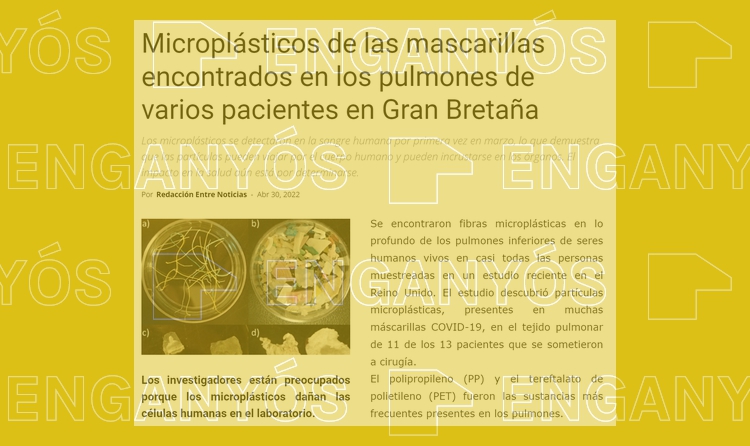No evidence that microplastics found in human lungs come from face masks

We analyze a post claiming that some researchers found microplastics that came from face masks in human lung tissue.

You sent us a post claiming that some researchers at the University of Hull in the United Kingdom found microplastics that came from face masks in human lung tissue. It is MISLEADING. The study exists and its findings were published in March 2022, but the sample was taken before the pandemic, when the use of face masks was not yet widespread. What’s more, the research, which effectively identified microplastics in all the regions of the human lungs, does not talk about face masks at any point or suggest that they could be the origin of these microplastics.
Microplastics from face masks found in the lungs of various patients in Great Britain
Original article does not mention face masks
The post we are analysing was based on an article published by the University of Hull (UK), the institution to which the lead author of the article belongs, in March 2022. However, as a press officer from the institution that led the study points out to Verificat, the sample of the analysed lungs “was carried out before the pandemic, when face masks were not an issue”. The sampling was approved in 2012, as indicated in a document from the National Research Ethics Service and the Health Research Authority of the NHS.
The study analysed samples of human lung tissue (obtained by thoracic surgical procedures from living donors) via spectroscopy (Spanish only) – a method based on detecting the absorption or emission of electromagnetic radiation by a substance to be studied – in order to detect and characterise any microplastic present. The same article explains that microplastics (MP) are plastic particles between 1 μm and 5 mm, and “present in all environmental compartments; from marine and freshwater bodies, to soil, food, drinking water and air”.
In total, they identified microplastics in 11 of the 13 samples analysed. Of these, the most abundant types of identified microplastics were polypropylene or PP (23%), polyethylene terephthalate or PET (18%) and resin (15%). As indicated in a review of the Royal Society of Chemistry, the respiratory filters of the face masks are usually made of polypropylene, and polyethylene (PE) is also used in the fabrication of face masks. The review also points out resin as a possible component of face masks. However, the study does not discuss the origin of the microplastics found in lungs at any point, let alone make any suggestion that they came from the face masks.
A press spokesperson from the University of Hull said to Verificat that “the study was not based on microplastics and the use of face masks”. In other words, “the study by Dr Sadofsky did not include the use of face masks”.
Presence of possible toxins in face masks
Currently there are very few studies that assess the potential risks posed to humans due to the prolonged use of a face mask. Although no link between face masks and microplastics found in human lungs has been established, one study published in the journal “Environment International” in September 2021 analysed the content of organophosphate triesters (OPE) –chemical products used widely used as plasticisers and flame retardants – in different types of face masks for the first time.
As Ethel Eljarrat, principal author of this study, explains to Verificat, the objective was to analyse the chemical additives that contain these plastic polymers. “The plastics are made up of a polymer to which different compounds are added to give it the desire properties”, she says. Some of these compounds are, for example, plasticisers or flame retardants.
Eljarrat explains to Verificat that “we found these types of compounds in varying levels in all the face masks”. To perform the evaluation, the researchers used dummies where they pumped air simulating 4 to 8 hours of mask use and afterwards they looked at whether the air they were breathing had these elements present. “We saw (…) that we were breathing in 10% (…) [of the chemical additives of the] mask while using it”, added Eljarrat.
However, the author notes that “the United States Environmental Protection Agency (EPA) has established daily exposure limits, which, when exceeded (…) can involve a risk”. The evaluation of the exposure levels led to the conclusion that the exposure levels “were sufficiently lower” than the ones established by the EPA as dangerous.
Microplastics in food and air
“We are exposed to this type of plasticiser in everything we eat and drink, because they are present in foods and beverages, and also in the air we breathe, above all in interior environments”, says Eljarrat, concluding that “the use of face masks on its own would not have a harmful effect, but (…) it is another entryway in addition to the ones we usually have”.
The article from the University of Hull also explains this problem: “Citizens are exposed to higher concentrations of MP within their homes or outdoor areas of high human activity, and this results in ubiquitous and unavoidable human exposure. Consequently, there is an increasing concern regarding the hazards associated with MP ingestion, dermal contact, and inhalation”. In fact, a study published in March 2022 found microplastics in human blood for the first time. The article concludes that the findings support “the hypothesis that human exposure to plastic particles results in absorption of particles into the bloodstream” and ends up raising the question of whether this exposure can affect immune regulation or the predisposition to immune-based diseases.